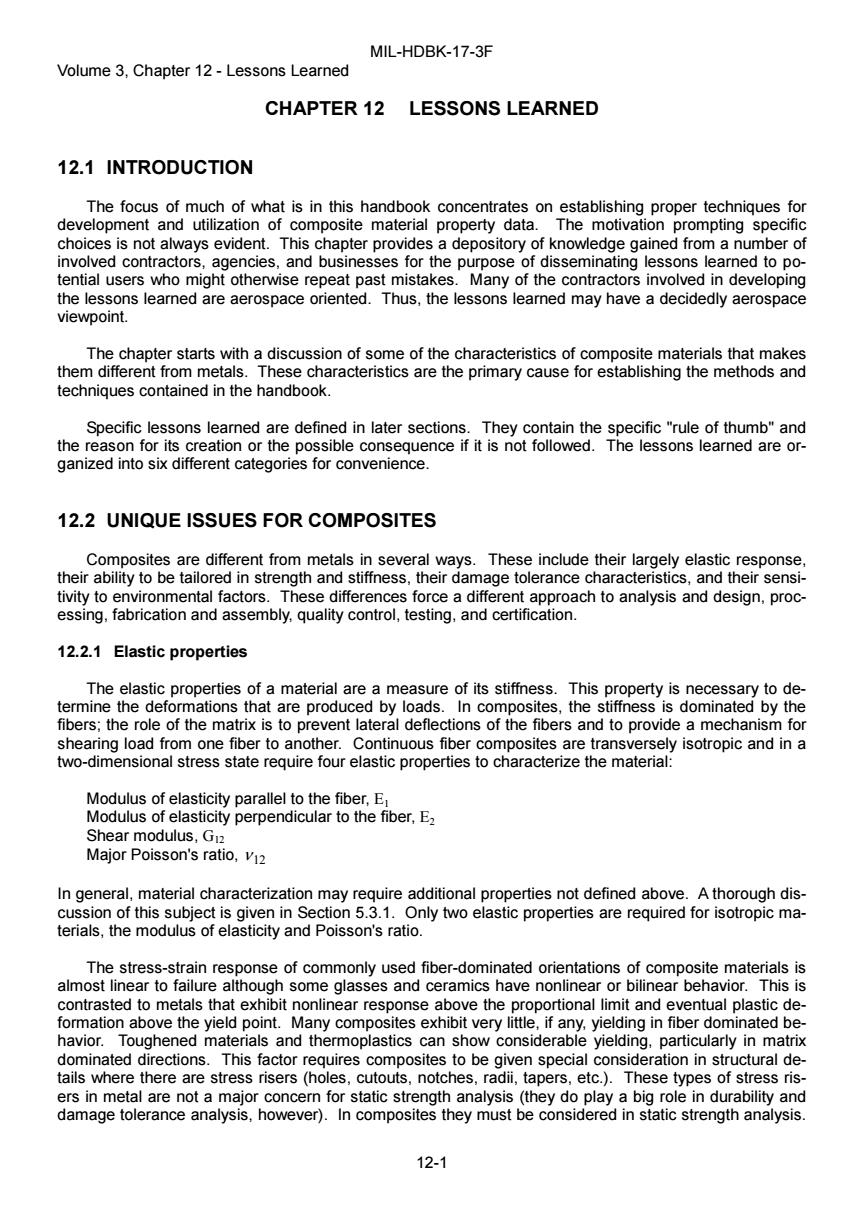正在加载图片...

MIL-HDBK-17-3F Volume 3,Chapter 12-Lessons Learned CHAPTER 12 LESSONS LEARNED 12.1 INTRODUCTION The focus of much of what is in this handbook concentrates on establishing proper techniques for development and utilization of composite material property data.The motivation prompting specific choices is not always evident.This chapter provides a depository of knowledge gained from a number of involved contractors,agencies,and businesses for the purpose of disseminating lessons learned to po- tential users who might otherwise repeat past mistakes.Many of the contractors involved in developing the lessons learned are aerospace oriented.Thus,the lessons learned may have a decidedly aerospace viewpoint. The chapter starts with a discussion of some of the characteristics of composite materials that makes them different from metals.These characteristics are the primary cause for establishing the methods and techniques contained in the handbook. Specific lessons learned are defined in later sections.They contain the specific "rule of thumb"and the reason for its creation or the possible consequence if it is not followed.The lessons learned are or- ganized into six different categories for convenience. 12.2 UNIQUE ISSUES FOR COMPOSITES Composites are different from metals in several ways.These include their largely elastic response, their ability to be tailored in strength and stiffness,their damage tolerance characteristics,and their sensi- tivity to environmental factors.These differences force a different approach to analysis and design,proc- essing,fabrication and assembly,quality control,testing,and certification. 12.2.1 Elastic properties The elastic properties of a material are a measure of its stiffness.This property is necessary to de- termine the deformations that are produced by loads.In composites,the stiffness is dominated by the fibers;the role of the matrix is to prevent lateral deflections of the fibers and to provide a mechanism for shearing load from one fiber to another.Continuous fiber composites are transversely isotropic and in a two-dimensional stress state require four elastic properties to characterize the material: Modulus of elasticity parallel to the fiber,E Modulus of elasticity perpendicular to the fiber,E2 Shear modulus,Gi2 Major Poisson's ratio,v12 In general,material characterization may require additional properties not defined above.A thorough dis- cussion of this subject is given in Section 5.3.1.Only two elastic properties are required for isotropic ma- terials,the modulus of elasticity and Poisson's ratio. The stress-strain response of commonly used fiber-dominated orientations of composite materials is almost linear to failure although some glasses and ceramics have nonlinear or bilinear behavior.This is contrasted to metals that exhibit nonlinear response above the proportional limit and eventual plastic de- formation above the yield point.Many composites exhibit very little,if any,yielding in fiber dominated be- havior.Toughened materials and thermoplastics can show considerable yielding,particularly in matrix dominated directions.This factor requires composites to be given special consideration in structural de- tails where there are stress risers (holes,cutouts,notches,radii,tapers,etc.).These types of stress ris- ers in metal are not a major concern for static strength analysis(they do play a big role in durability and damage tolerance analysis,however).In composites they must be considered in static strength analysis. 12-1MIL-HDBK-17-3F Volume 3, Chapter 12 - Lessons Learned 12-1 CHAPTER 12 LESSONS LEARNED 12.1 INTRODUCTION The focus of much of what is in this handbook concentrates on establishing proper techniques for development and utilization of composite material property data. The motivation prompting specific choices is not always evident. This chapter provides a depository of knowledge gained from a number of involved contractors, agencies, and businesses for the purpose of disseminating lessons learned to potential users who might otherwise repeat past mistakes. Many of the contractors involved in developing the lessons learned are aerospace oriented. Thus, the lessons learned may have a decidedly aerospace viewpoint. The chapter starts with a discussion of some of the characteristics of composite materials that makes them different from metals. These characteristics are the primary cause for establishing the methods and techniques contained in the handbook. Specific lessons learned are defined in later sections. They contain the specific "rule of thumb" and the reason for its creation or the possible consequence if it is not followed. The lessons learned are organized into six different categories for convenience. 12.2 UNIQUE ISSUES FOR COMPOSITES Composites are different from metals in several ways. These include their largely elastic response, their ability to be tailored in strength and stiffness, their damage tolerance characteristics, and their sensitivity to environmental factors. These differences force a different approach to analysis and design, processing, fabrication and assembly, quality control, testing, and certification. 12.2.1 Elastic properties The elastic properties of a material are a measure of its stiffness. This property is necessary to determine the deformations that are produced by loads. In composites, the stiffness is dominated by the fibers; the role of the matrix is to prevent lateral deflections of the fibers and to provide a mechanism for shearing load from one fiber to another. Continuous fiber composites are transversely isotropic and in a two-dimensional stress state require four elastic properties to characterize the material: Modulus of elasticity parallel to the fiber, E1 Modulus of elasticity perpendicular to the fiber, E2 Shear modulus, G12 Major Poisson's ratio, ν 12 In general, material characterization may require additional properties not defined above. A thorough discussion of this subject is given in Section 5.3.1. Only two elastic properties are required for isotropic materials, the modulus of elasticity and Poisson's ratio. The stress-strain response of commonly used fiber-dominated orientations of composite materials is almost linear to failure although some glasses and ceramics have nonlinear or bilinear behavior. This is contrasted to metals that exhibit nonlinear response above the proportional limit and eventual plastic deformation above the yield point. Many composites exhibit very little, if any, yielding in fiber dominated behavior. Toughened materials and thermoplastics can show considerable yielding, particularly in matrix dominated directions. This factor requires composites to be given special consideration in structural details where there are stress risers (holes, cutouts, notches, radii, tapers, etc.). These types of stress risers in metal are not a major concern for static strength analysis (they do play a big role in durability and damage tolerance analysis, however). In composites they must be considered in static strength analysis